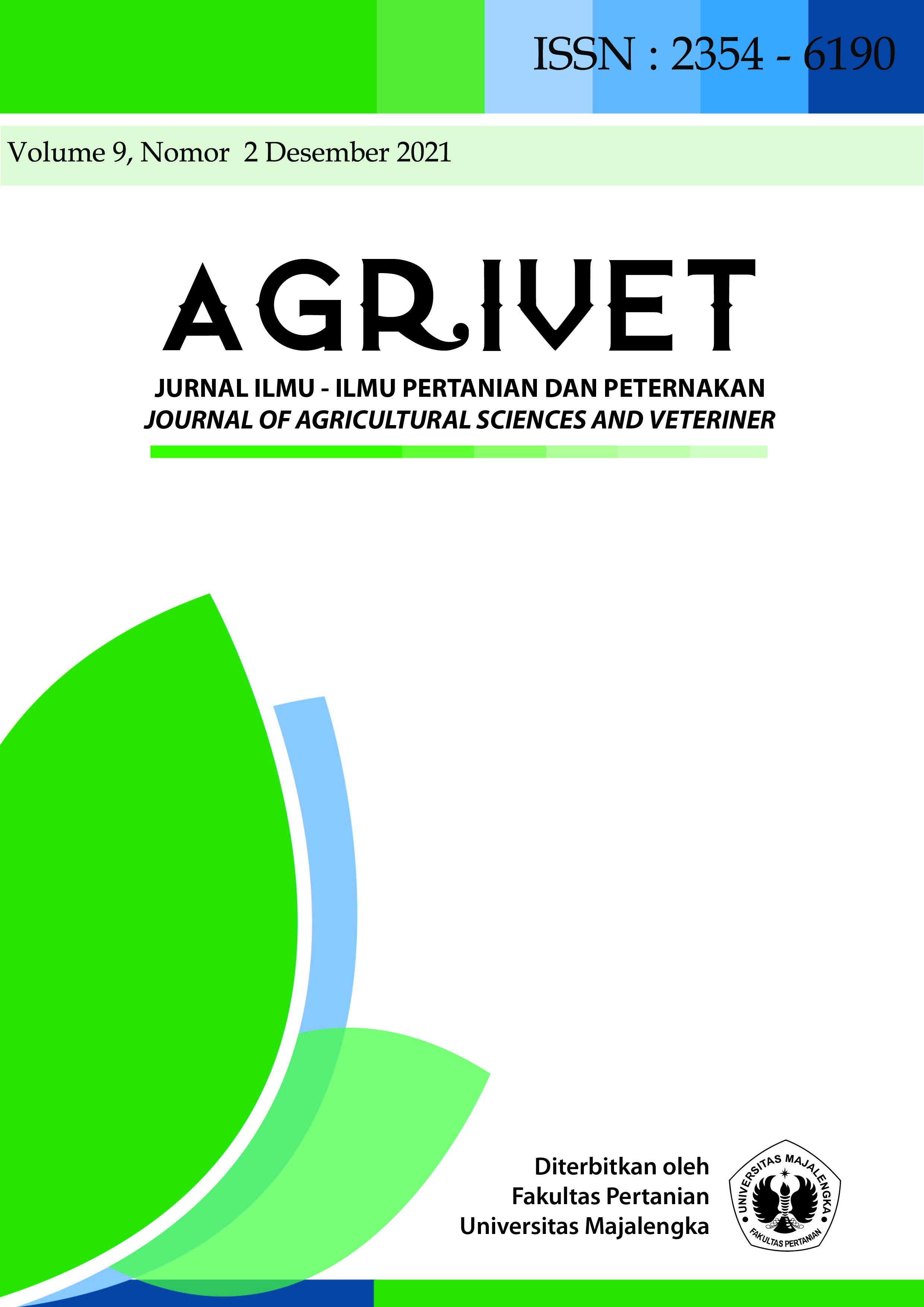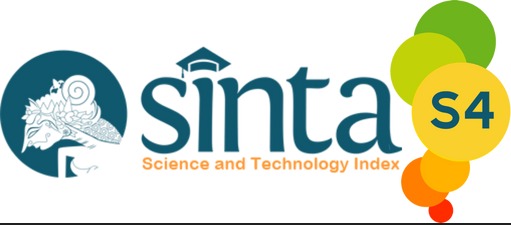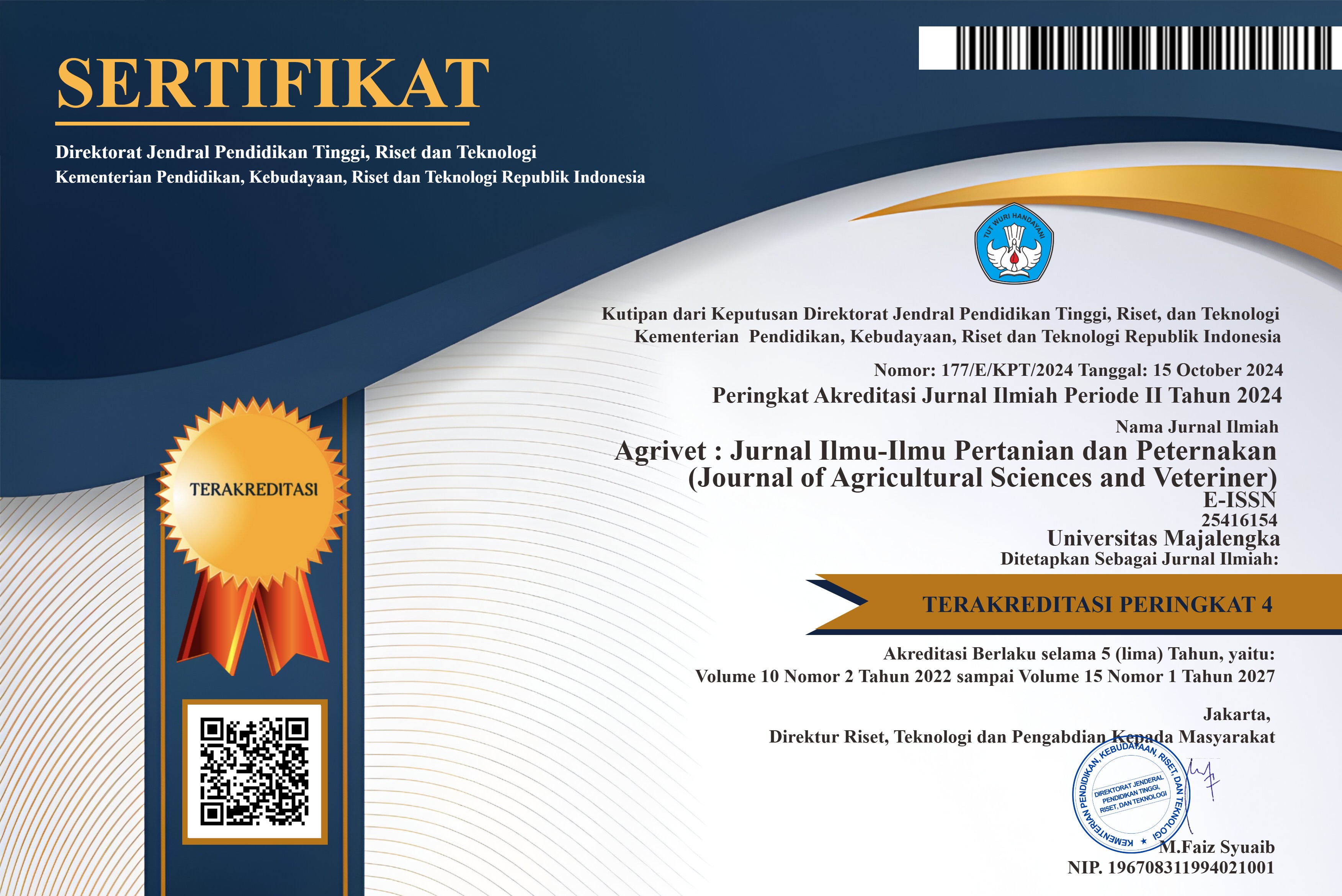KARAKTERISTIK SIFAT KIMIA BIJI KOPI ARABIKA DENGAN BEBERAPA METODA PENGOLAHAN di KABUPATEN SIMALUNGUN PROVINSI SUMATERA UTARA
DOI:
https://doi.org/10.31949/agrivet.v9i2.1701Abstract
Coffee in North Sumatra have an important meaning in the socio-economic aspects of people's lives. One of the problems with developing coffee in Simalungun is the low quality of products. Determinants of coffee quality are influenced by geographical indications of the origin of coffee and how the coffee is processed. The purpose of this study was to determine the chemical characteristics of coffee beans produced from several locations in Simalungun Regency, North Sumatra with various coffee processing methods. The material used is red cherry Arabica coffee fruit taken from several locations, namely Raya District, Purba District and Dolok Pardamean District, with a variety of processing methods (dry method, semi-wash method, full-wash method, and honey method). The observed parameters where the chemical characteristics of coffee bean, including water content, caffeine content, ash content, and free fatty acid content. The results showed that the characteristics of the chemical properties of coffee beans produced by various processing methods were not different. Caffeine levels of coffee beans ranged from 7808.71 mg / kg the lowest to the highest 10422.11 mg / kg. Ash content ranged from 3.71%, the lowest to the highest 4.4%. Free fatty acid content from three district an average was 0.06%.
Keywords:
coffee processing, chemical characteristics, caffeine, free fatty acidDownloads
References
Anonim, 2013. Diagram Alir Metode Uji Kadar Abu Sesuai SNI 01-2891-1992. Instruksi Kerja. PT. Saraswanti Indo Genetech. Bogor.
Anonim, 2018. Diagram Alir Penentuan Kadar Air Sesuai SNI 2907-2008, SNI 01-3542-2004 SNI 01-4282-1996, SNI 7708-2011 SNI 6685-2009, dan SNI 01-4446-1998. Instruksi Kerja. PT. Saraswanti Indo Genetech. Bogor.
Anonim, 2012. Diagram Alir Pengujian Kafein Dengan HPLC. Instruksi Kerja. PT. Saraswanti Indo Genetech. Bogor.
Anonim, 2017. Menilik Pengembangan Kopi Sumut. http :// www. Medanbisnisdaily.com, 19 Juni 2017. Menilik Pengembangan Kopi Sumut. (Diakses tanggal 11 Maret 2019).
Anonim, 2016. Sumut Berpotensi Kembangkan Perkebunan Kopi 850.000 Hektare. http :// www. Medanbisnisdaily.com, 23 Agustus 2016. Sumut Berpotensi Kembangkan Perkebunan Kopi 850.000 Hektare. (Diakses tanggal 11 Maret 2019).
Mulato, S., S. Widyotomodan E. Suharyanto. 2006. Teknologi Proses dan Pengolahan Produk Primer dan Sekunder Kopi Jember. Pusat Penelitian Kopi dan Kakao. Jember
Najiyati, S., dan Danarti. 2007. Kopi, Budi Daya dan Penanganan Pascapanen. Penebar Swadaya, Jakarta.
Novita, E., R. Syarief, E. Noor, S. Mulato, 2010. Peningkatan Mutu Biji Kopi Rakyat Dengan Pengolahan Semi Basah Berbasis Produksi Bersih. Jurnal Agrotek Vol.4, No.1.
Panggabean, E., 2011. Buku Pintar Kopi. Agromedia, Jakarta.
Saragih, J.R, 2012. Produksi Kopi Arabika Spesialti Sumatera Utara : Analisis Sosial Ekonomi, Ekologi, dan Kebijakan Pemerintah Daerah. Prosiding Seminar Ilmiah Dies Natalis ke 60 Universitas Sumatera Utara, Medan. ISSN 2088-8244.
Standar Nasional Indonesia 01-2907-2008. Biji Kopi. Badan Standarisasi Nasional.
Published
How to Cite
Issue
Section
License
An author who publishes in the Jurnal Agrivet agrees to the following terms:
- Author retains the copyright and grants the journal the right of first publication of the work simultaneously licensed under the Creative Commons Attribution-ShareAlike 4.0 License that allows others to share the work with an acknowledgment of the work's authorship and initial publication in this journal
- The author is able to enter into separate, additional contractual arrangements for the non-exclusive distribution of the journal's published version of the work (e.g., post it to an institutional repository or publish it in a book) with the acknowledgment of its initial publication in this journal.
- The author is permitted and encouraged to post his/her work online (e.g., in institutional repositories or on their website) prior to and during the submission process, as it can lead to productive exchanges, as well as earlier and greater citation of the published work









